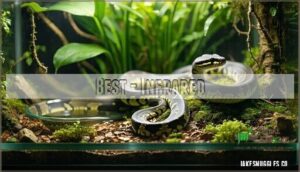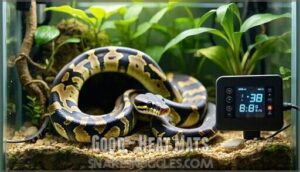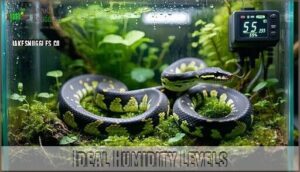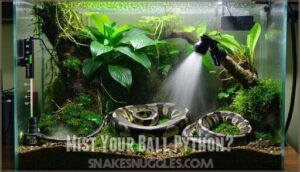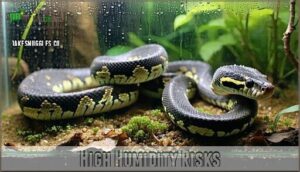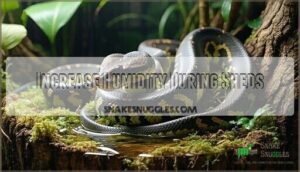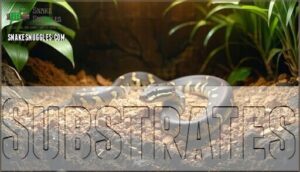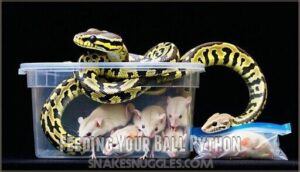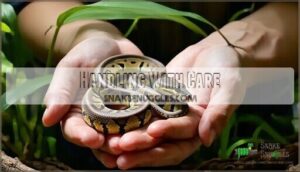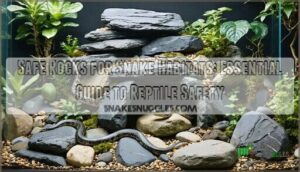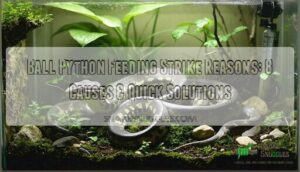This site is supported by our readers. We may earn a commission, at no cost to you, if you purchase through links.
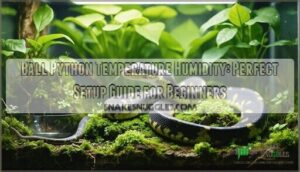 Your ball python needs specific ball python temperature humidity levels to thrive.
Your ball python needs specific ball python temperature humidity levels to thrive.
Keep the basking spot at 88-92°F, while the cool side should stay around 78-80°F.
Humidity levels must remain between 55-60% year-round, though you’ll bump this up to 70-80% when your snake’s about to shed.
You can’t wing it with these numbers – they’re not suggestions.
Too cold and your python won’t digest food properly.
Too hot and you’ll stress them out.
Wrong humidity causes stuck sheds or respiratory infections.
Use quality thermometers and hygrometers to monitor both ends of the enclosure.
Getting the setup right prevents most health issues you’ll encounter.
Table Of Contents
- Key Takeaways
- Ideal Temperatures
- Necessary Heating Elements
- Ideal Humidity Levels
- Mist Your Ball Python?
- High Humidity Risks
- Increase Humidity During Sheds
- Habitat Setup
- Feeding Your Ball Python
- Handling With Care
- Frequently Asked Questions (FAQs)
- Is 70% humidity too high for a ball python?
- What is the ideal temperature and humidity for a ball python?
- Is 90 degrees too hot for a ball python?
- Is 40 humidity too low for ball python?
- What temperature should a ball python be?
- Do ball pythons need humidity?
- How do you know if a ball python is humid?
- How humid should a ball python terrarium be?
- How humid should a ball python enclosure be?
- Does misting a ball python increase humidity?
- Conclusion
Key Takeaways
- You’ll need to maintain a temperature gradient with 88-92°F on the basking side and 78-80°F on the cool side – your python can’t regulate its body temperature without this range.
- Keep humidity levels between 55-60% year-round, then bump it up to 70-80% during shedding periods to prevent stuck sheds and respiratory infections.
- You can’t rely on guesswork – invest in quality digital thermometers and hygrometers to monitor both ends of the enclosure daily.
- Use infrared or halogen heating elements with thermostats rather than heat mats alone – overhead heating creates a natural temperature gradient your snake needs to thrive.
Ideal Temperatures
You’ll need to maintain specific temperature zones throughout your ball python’s enclosure to keep them healthy and comfortable.
Creating the right temperature gradient allows your snake to regulate its body heat by moving between warm and cool areas as needed.
Basking Surface
Creating the perfect basking surface for your ball python isn’t rocket science, but getting the temperature right makes all the difference. Your snake needs a consistent basking spot between 90-95°F to properly regulate its body temperature and display natural basking behavior.
The perfect basking spot transforms your python from sluggish to thriving—temperature precision makes all the difference.
The right surface material paired with proper bulb wattage creates an ideal thermal zone. Position your heat lamp at the optimal distance of 6-8 inches above the basking area to maintain steady heat distribution.
Consider these proven surface options:
- Flagstone tiles retain heat excellently and clean easily
- Ceramic tiles provide consistent warmth with smooth texture
- Cork bark offers natural appeal with good heat retention
- Commercial basking platforms guarantee proper grip and safety
This setup creates the essential temperature gradient your python craves. You can find essential basking products online.
Warm Hide
Your ball python’s warm hide serves as their cozy retreat where they’ll spend most daylight hours feeling secure.
This essential component of your python enclosure temperature setup must maintain 86-90°F consistently.
Perfect warm hide setup requires attention to these key factors:
- Hide Material – Choose ceramic or thick plastic that retains heat effectively
- Size Matters – Select snug dimensions where your snake touches three sides comfortably
- Hide Placement – Position directly over your heat source on the warm side
- Thermostat Probe – Place inside the hide to monitor actual temperatures your python experiences
Cool Hide
Your ball python’s cool hide serves as their temperature refuge on the enclosure’s cool side.
Maintain temperatures between 78-80°F here—never below 75°F.
This creates the proper temperature gradient your snake needs for thermoregulation.
Cool hide size matters: choose one where your python can curl up with body contact on all sides.
Location importance can’t be overstated—place it opposite your heat source.
Material safety requires non-toxic options like ceramic or wood.
Substrate choice around the hide should retain some moisture without becoming soggy.
daily
Nighttime
After setting up your cool hide properly, you’ll need to adjust nighttime temperatures as darkness falls. Your ball python’s nocturnal behavior requires specific temperature management during their active hours.
Nighttime Temperatures should drop 3-5°F from daytime settings. This gentle Temperature Drop mimics natural conditions without shocking your snake’s system.
Maintain your temperature gradient with these zones:
- Cool side: 75-78°F for comfortable resting
- Warm side: 82-85°F supporting natural movement
- Overall difference: Keep 7-10°F between sides
Darkness Benefits include improved sleep patterns and reduced stress. Monitor humidity levels closely, as Humidity Spikes often occur during cooler night temperatures when your snake becomes more active.
Necessary Heating Elements
You’ll need specific heating equipment to create the proper temperature gradient your ball python requires for healthy thermoregulation.
The right heating elements guarantee your snake can move between warm and cool areas to maintain its ideal body temperature throughout the day and night, ensuring proper temperature control.
Best – Infrared
Now that you’ve established proper temperature ranges, infrared heating delivers the gold standard for ball python temperature control.
These units provide superior output that closely mimics natural sunlight, creating the perfect python heating setup.
Your snake will thrive with these infrared benefits:
- Deep tissue warming – Infrared-A radiation penetrates scales effectively, promoting healthy circulation
- Even heating distribution – Eliminates hot spots while maintaining consistent temperature gradient across the enclosure
- Nighttime use compatibility – Provides essential warmth without disrupting sleep cycles or ball python humidity levels
Unlike other heating methods, infrared sources don’t create harsh light that stresses your python.
They maintain steady basking temperatures while preserving the natural moisture your snake needs for ideal health.
Good – Halogen Bulbs
Halogen benefits make these bulbs a smart choice for your python heating setup.
You’ll get focused infrared radiation that penetrates deep into your snake’s body, promoting healthy circulation and digestion.
Unlike ceramic heaters, halogen bulbs provide both warmth and beneficial light spectrum.
Dimmable options let you fine-tune your ball python temperature without constantly swapping bulbs.
A 50-75 watt halogen bulb typically creates the perfect basking zone of 90-95°F when positioned 12-18 inches above your snake’s favorite spot.
Even heating across the basking area prevents hot spots that could burn your python.
These affordable bulbs cost less than specialty reptile lighting while delivering superior performance.
Mount your heat lamp in a reflective dome fixture to maximize efficiency.
You can find a wide selection online for your reptile setup.
Replace halogen bulbs every 6-12 months as their infrared radiation output decreases over time, even when they still produce visible light.
Good – Heat Mats
Heat mats serve as reliable secondary heat sources that complement overhead heating systems in your ball python setup.
These heating pads work best when you follow proper safety protocols and maintain consistent temperature monitoring.
Smart heat mat usage requires three key steps:
- Connect your heat mat to a thermostat – This prevents dangerous overheating that could burn your snake or damage your enclosure
- Position the probe correctly – Place it inside the warm hide at your python’s level, not on the glass surface
- Monitor temperatures daily – Check that your warm hide stays around 90°F while avoiding burns from direct contact
Thermostat control transforms a basic heating pad into a safe, regulated system.
You can find a heat mat thermostat online.
Remember that heat mats work as secondary sources alongside overhead heating, creating the perfect thermal gradient your ball python needs for proper thermoregulation.
Okay – Radiant Panels
Radiant heat panels work like invisible sunshine, warming your enclosure from above with steady, controlled heat.
These panels create focused hot spots without drastically raising ambient temperatures throughout the habitat.
Key advantages of radiant heat panel installation include:
- Panel Installation requires simple mounting with included hardware
- Energy Efficiency converts electricity directly into infrared warmth
- Safety Features include automatic shutoff and even heat distribution
- Panel Lifespan typically exceeds five years with proper thermostat regulation
Ideal Humidity Levels
Now that you’ve got your heating sorted, let’s talk about getting your ball python humidity levels just right. Your snake needs 55-60% humidity most of the time – think of it as the sweet spot where everything clicks.
Humidity monitoring isn’t optional. Grab a digital hygrometer and check those numbers daily. Poor hydration levels below 50% lead to shedding problems and respiratory health issues. Push above 80%, and you’re inviting fungal prevention nightmares like scale rot.
Here’s what proper python enclosure humidity gives you:
- Perfect one-piece sheds that peel off like a sock
- Healthy respiratory function without wheezing or infections
- Peace of mind knowing your python humidity levels are dialed in
During shedding periods, bump that proper humidity range up to 65-70%. Your snake will thank you with flawless molts every time.
Mist Your Ball Python?
You’ve got your humidity levels dialed in, but should you mist your ball python’s enclosure? The answer depends on your current python humidity levels and setup.
Misting Benefits include quick humidity boosts and better python enclosure humidity control. However, Water Quality matters – always use filtered or dechlorinated water to avoid harmful chemicals.
The following guidelines can help you determine the appropriate misting frequency for your ball python’s enclosure:
Misting Frequency
Humidity monitoring after misting prevents oversaturation. Never spray your snake directly – this causes stress and Respiratory Concerns. Instead, mist substrate and enclosure walls.
Consider Alternative Hydration methods like automatic misters for consistent results without daily maintenance.
High Humidity Risks
While misting helps maintain proper ball python humidity, excessive moisture creates a breeding ground for serious health problems.
When humidity levels climb above 70%, you’re basically turning your snake’s home into a petri dish.
Here are five major risks of high humidity:
- Respiratory infections develop rapidly in overly moist environments
- Scale rot occurs when belly scales contact wet surfaces repeatedly
- Fungal growth thrives in damp, warm conditions
- Bacterial issues multiply quickly without proper ventilation needs
- Mold development releases harmful spores into the air
Digital hygrometers provide accurate readings to prevent these problems.
Position enclosures away from naturally humid rooms like bathrooms.
Remember, preventing humidity-related respiratory infection is much easier than treating it.
Increase Humidity During Sheds
During your ball python’s shedding cycle, you’ll need to bump up humidity levels to prevent shedding problems.
Watch for key shedding signs: cloudy eyes, dull coloration, and increased hiding behavior.
Your humidity control strategy should shift based on each phase.
Misting frequency increases during pre-shed, while substrate moisture becomes critical as shedding approaches.
Install humid hideouts filled with damp sphagnum moss.
| Shedding Phase | Humidity Target |
|---|---|
| Pre-shed | 60-65% |
| Blue phase | 70-75% |
| Active shed | 75-80% |
| Post-shed | 50-60% |
| Problem shed | 80% with soaking |
Ball python humidity management during sheds prevents stuck pieces and respiratory issues.
Once shedding completes, return humidity levels to normal ranges immediately.
Habitat Setup
You’ll need to select the right substrates, hides, and climbing branches to create a comfortable environment that supports your ball python’s natural behaviors.
These essential components work together with proper temperature and humidity levels to guarantee your snake stays healthy and stress-free.
Substrates
Looking at substrate types transforms your ball python’s habitat from basic to brilliant.
Your snake needs a foundation that maintains 70-85% humidity while supporting natural burrowing behavior.
Coco coir and cypress mulch excel as moisture-retentive substrates, keeping humidity stable without creating soggy conditions.
Choose reptile substrates based on these essential criteria:
- Moisture retention – Holds humidity without waterlogging your enclosure
- Cleaning frequency – Requires spot-cleaning only, with monthly full changes
- Mold prevention – Resists fungal growth in humid environments
- Depth capacity – Supports 4-inch layers for proper humidity buffering
- Burrowing support – Allows natural digging behaviors safely
Quality substrate choices create the humidity foundation your ball python needs for thriving health.
Hides
While your ball python spends most of its day hidden away, proper hides create the foundation for a stress-free environment. You’ll need at least two reptile hide spots: one warm hide (86-90°F) and one cool hide (78-80°F).
Hide size matters—choose snug spaces where your python touches all sides for maximum security. Hide materials like ceramic, resin, or cork bark work best. Secure hides prevent dangerous tipping incidents.
| Hide Type | Temperature | Purpose |
|---|---|---|
| Warm Hide | 86-90°F | Digestion, thermoregulation |
| Cool Hide | 78-80°F | Cooling, resting |
| Humid Hide | 70-75% humidity | Shedding support |
Consider adding a humid hide filled with damp sphagnum moss to boost ball python humidity during sheds. Multiple hides give your snake choices for comfort and proper hide placement supports natural behaviors.
Climbing Branches
After setting up proper hides, you’ll want to add climbing branches that boost your snake’s quality of life. These natural structures provide enrichment value beyond decoration—they encourage exercise and mental stimulation your ball python needs.
Branch material selection matters for safety. Choose hardwoods like oak, maple, or commercial grape vine that won’t splinter or harbor harmful bacteria. Branch size should accommodate your snake’s girth comfortably without causing strain.
Branch placement requires strategic thinking. Position them to maintain your humidity levels and temperature gradients while creating vertical pathways. The climbing benefits include muscle development and behavioral enrichment that reduces stress in your snake enclosure.
Consider these placement tips:
- Install branches away from heat sources to prevent overheating
- Secure mounting prevents dangerous falls during nighttime activity
- Multiple levels create natural ball python humidity circulation patterns
Feeding Your Ball Python
Your ball python’s nutrition directly impacts python health and requires careful attention to detail. Prey size should match your snake’s thickest body section to prevent regurgitation and digestive issues.
Feed smart, feed safe—the right prey size keeps your python healthy and happy.
Prey Size
Feeding Frequency
Food Type
Live Feeding
Environment
Frozen thawed prey eliminates injury risks from live feeding while maintaining proper ball python care standards.
Feeding frequency of 7-10 days supports healthy python husbandry. Understanding refusal reasons helps troubleshoot appetite issues in your python temperature guide routine.
Handling With Care
Proper ball python care starts with mastering safe handling techniques that protect both you and your snake.
Ball pythons thrive with thoughtful touch—your gentle hands build trust that lasts a lifetime.
Here are 8 essential handling practices to master:
- Always support the entire body – your python needs full contact to feel secure rather than dangling
- Wait 48 hours after feeding – handling too soon causes regurgitation, disrupting digestion
- Move slowly and deliberately – sudden movements trigger defensive stress signs like tight coiling
- Practice proper hygiene practices – wash hands before and after to prevent bacteria transfer
- Monitor handling frequency – limit sessions to 15-20 minutes, 1-3 times weekly maximum
- Learn reading behavior cues – hissing, head hiding, and excessive coiling indicate stress
- Maintain temperature gradient awareness – avoid handling during shed cycles when humidity monitoring shows increased needs
- Approach from the side – direct overhead movements appear threatening to your python
Regular gentle interaction builds trust while supporting your python humidity guide and python temperature guide goals.
Frequently Asked Questions (FAQs)
Is 70% humidity too high for a ball python?
Walking the tightrope of humidity, 70% isn’t dangerous for your ball python, but it’s pushing the upper limit.
You’ll want to dial it back to 50-60% for daily comfort, reserving higher levels only during shedding periods.
What is the ideal temperature and humidity for a ball python?
Your ball python needs a temperature gradient with 88-92°F on the warm side and 76-80°F on the cool side.
You’ll want to maintain humidity between 50-60%, increasing to 70% during shedding periods.
Is 90 degrees too hot for a ball python?
Ninety degrees isn’t too hot for your ball python’s basking spot, but it’s pushing the upper limit.
You’ll want to keep general air temperatures below 95°F and provide cooler areas for proper thermoregulation.
Is 40 humidity too low for ball python?
Yes, 40% humidity is too low for your ball python.
You’ll need to maintain 50-60% humidity for proper health.
Low humidity causes shedding problems and respiratory issues that can seriously harm your snake.
What temperature should a ball python be?
Your ball python needs a warm side between 88-92°F and a cool side around 76-80°F.
You’ll want to maintain ambient temperatures of 81-83°F during the day, dropping to 75-78°F at night.
Do ball pythons need humidity?
Absolutely, you’ll need to maintain 50-60% humidity for your ball python’s health.
Without proper humidity levels, they’ll struggle with shedding, develop respiratory issues, and face serious dehydration problems that affect their overall well-being.
How do you know if a ball python is humid?
You’ll know your ball python’s environment is humid enough by checking your hygrometer regularly.
Look for readings between 50-60%, increasing to 70% during shedding.
Proper humidity prevents respiratory issues and incomplete sheds.
How humid should a ball python terrarium be?
Your ball python’s terrarium should maintain 50-60% humidity for ideal health.
You’ll want to increase it to 65-70% during shedding periods, then return to normal levels to prevent respiratory infections and scale rot.
How humid should a ball python enclosure be?
Like Goldilocks seeking the perfect porridge, you’ll want your ball python’s humidity hovering between 50-60%.
During shedding, bump it up to 65-70%.
Too low causes breathing issues; too high invites nasty bacterial growth.
Does misting a ball python increase humidity?
Yes, misting your ball python’s enclosure effectively increases humidity levels.
You’ll want to spray near the substrate and heating sources for best results, but monitor levels to avoid excessive moisture that can cause health problems.
Conclusion
Measure twice, cut once – this old saying applies perfectly to your ball python setup.
Getting ball python temperature humidity right isn’t complicated once you understand the basics.
Your snake depends on consistent 88-92°F basking temperatures, 78-80°F cool zones, and 55-60% humidity levels.
Don’t skip the quality monitoring equipment – cheap gauges lead to expensive vet bills.
With proper heating elements, substrate choices, and regular maintenance, you’ll create an environment where your ball python thrives for years.
- https://www.jabberwockreptiles.com/news/ball-python-temperature/
- https://amccorona.com/wp-content/uploads/2020/05/ARAV_trifold_ball_pythonv2_2.pdf
- https://inkbird.com/blogs/aquarium-terrarium/ball-python-enclosure-ideas-size-humidity-temperature
- https://www.reddit.com/r/snakes/comments/zzh86c/climate_for_ball_pythons/
- https://www.zillarules.com/information/care-sheets/ball-python

